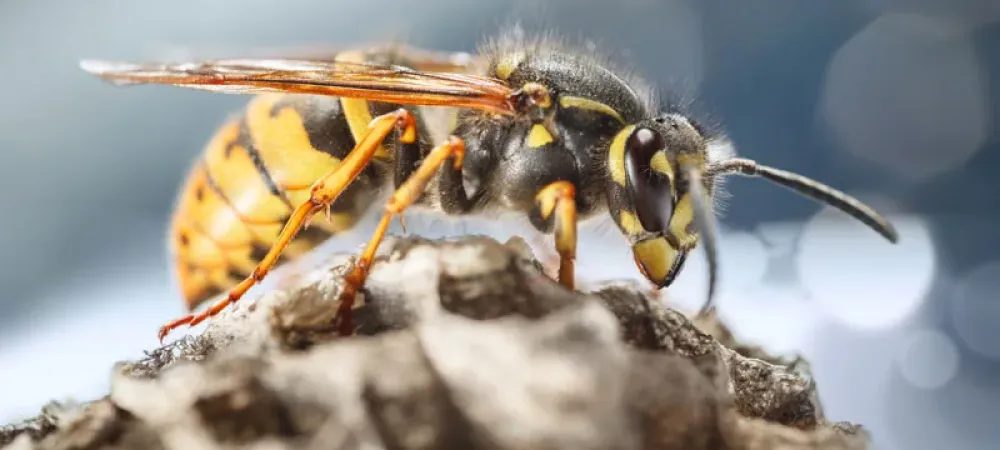How To Keep Hornets, Wasps, and Yellow Jackets out of Light Fixtures

You installed a new light fixture on your front porch and are hoping to sit outside and enjoy the nice weather. All of a sudden, you see a lot of bugs heading towards your light source and plan to stay throughout the night. Have you ever wondered why stinging insects like wasps are attracted to light? In this blog, we will discuss the reasoning behind this and what you can do to get rid of stinging insects invading your light fixtures.
Why are Stinging Insects Attracted to Light Fixtures?
It’s no surprise to see hornets, wasps, and yellow jackets around your home, but have you ever noticed how they will stay around a light source? There is no scientific reasoning behind why insects are attracted to light, but there are certain theories that lead to this:
Safety
Stinging insects always have to be on the lookout for predators, and with a light source, they can cover their surroundings much better. Many predators attack their prey when they are in the dark, making it easier to pounce on them. These bright lights confuse insects and make it harder for predators to find them. Lights can also obscure vision at night, making it difficult for predators to find stinging insects in the dark. This causes stinging insects to use light as an escape route instead of using darkness.
Navigation
When it comes to navigating, stinging insects use light sources as a common way to orient themselves. By orienting themselves with light, they can fly in a straight line and avoid obstacles. There are a few different theories as to why stinging insects use light to navigate. One possibility is that the light creates a false horizon, which helps the insects stay on course. Another possibility is that the light makes it easier for them to find food or mates. Have you ever wondered why stinging insects continuously fly themselves into light fixtures? This is because they follow navigation patterns from the sun and moon and when seeing a completely different source of light, like a fixture, this throws off an insect's pattern as they will continue to slam into it trying to get closer to the light source.
Heat
Hornets, wasps, and yellow jackets are all more active when the temperature is hot. When the sun goes down, these insects have less energy and will not be seen as much, unless there is a light source around. Light fixtures can give off a comfortable amount of heat which will attract the insects and give them more energy to look for food and warmth. Stinging insects have a strong exoskeleton, but fragile bodies which allow the cooler temperatures to affect their bodies more than other insects.
How to Prevent Stinging Insects From Finding Your Light Fixtures
Keeping yourself out of harm’s way from stinging insects will not only save you from potential stings, but it could save you from an allergic reaction that you don’t know you have. There should be no reason to worry about sitting outside and having the thought of a wasp, hornet, or yellow jacket finding your light fixture, and possibly you. Here are some tips and tricks to keep stinging insects away from your light fixtures:
- LED light bulbs - LED bulbs produce less heat than incandescent bulbs which will be less attractive to any wasps, yellow jackets, or hornets.
- Yellow bulbs - Tinted “yellow” bulbs are designed to repel flying insects because the color of the bulb makes it hard for them to see.
- Remove standing water - Standing water can be a perfect breeding zone for stinging insects and if there is a light fixture close to this area, they will have a destination to navigate to as the sun goes down.
DIY Tips to Get Rid of Hornets
Hornets are notorious for being one of the most aggressive stinging insects out there. If they find a light fixture to cling to, brushing them away has a great possibility of irritating these pests to sting you. If you try to kill them, they will relay a scent that can attract more hornets to your property. Below are some DIY tips for getting rid of hornets before they find your light fixture:
Keep trash cans covered
Hornets are attracted to the smell of garbage, especially on a warm day. If your trash can is not properly cleaned, this scent can attract not only the closest hornet’s nest to you, but another completely different nest. The best way to combat this is to spray out your garbage can to make sure there is no leftover trash or debris. After this, always keep the lid tightly closed to eliminate any entry points possible.
Soap and Water Hornet Repellent
An effective, eco-friendly way to get rid of hornets is using soap and water repellent. This mixture will enter the insect’s exoskeleton to slow them down. We recommend if you are attempting to spray an entire nest, wear protective gear and do it from a distance as hornets can be very aggressive.
Home Remedies to Get Rid of Wasps
Wasps are not afraid to get close to humans. A lot of times, we will see ourselves trying to get out of their sight because of their painful stings. Wasps are not only attracted to outdoor lights, but they will try to access inside your home for brighter light sources to search for hosts. Below are some home remedies that can stop any wasp infestation:
Cover Cracks and Crevices Around your Home
Wasps can enter through almost any crack and crevice as their bodies are very flexible. First, check to see if there are any noticeable entry areas throughout your property. After this, look and see if you locate any wasp nests and if you find one, check that area very closely to make sure there are no crevices that could provide entry.
Peppermint Oil Wasp Repellent
Peppermint, known for its strong vibrant smell, is known to be one of the most effective wasp repellents out there as they have a disliking for anything mint. This will not kill the insect, instead, it will be used to deter any wasps from staying in your area. Use this to spray every couple of days until wasps have relocated for good.
Natural Remedies to Get Rid of Yellow Jackets
Although yellow jackets are not very active during the night when your light sources start turning on, these pests usually build their nests in an enclosed area that happens to be near light fixtures. Light can provide a heat source for yellow jackets and this will be a common reason why they will leave their nest to cling to any fixtures around your home. Below are some natural remedies to eliminate a yellow jacket presence:
Planting Wormwood
While very strong, wormwood is a great plant for getting rid of yellow jackets. Wormwood contains absinthe which is toxic to insects and the scent alone will keep them away. When planting wormwood, make sure to keep it away from other plants as it can kill off any plant close by.
Fresh Scents like Cucumber and Dryer Sheets
Yellow jackets are not fond of fresh scents like cucumber and dryer sheets. If you are noticing high yellow jacket activity, cut up fresh cucumber or bring dryer sheets outside and place them in a container. This scent will deter any yellow jacket from coming your way and you can enjoy your light fixtures without worrying about getting stung.

